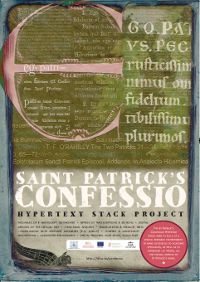Publicity
A truly invaluable and unique tool for research ...
a fascinating example of what is possible when you bring technological expertise and scholarship together
We are delighted to say that these words have appeared in an independent scholarly review, by the Forum for Medieval and Renaissance Studies in Ireland (FMRSI), of the St Patrick’s Confessio Hypertext Stack
DUBLIN ARCHBISHOPS LAUNCH ST PATRICK LIVE ON LINE
ROYAL IRISH ACADEMY PUBLISHES INTERNET RESOURCE FOR
INVESTIGATING THE SAINT’S OWN WRITINGS
Not everyone realizes that there are two Latin works, still surviving, that can definitely be attributed to Patrick’s own authorship. Composed in the fifth century and preserved in manuscripts dating from the 800s onwards, these are the very oldest texts, in any language, written in Ireland that are still extant.
These texts prove that St Patrick really existed, because they allow us to define the historical Patrick as the person who wrote them. This real St Patrick is thus the very first recordable individual that we can identify for certain in Ireland. At a well-attended launch on 14th September 2011 the Royal Irish Academy published his writings in a freely accessible form on line at www.confessio.ie, both in the original Latin and in a variety of modern languages (including Irish). The English translation is a straightforward and accurate rendering titled My Name is Patrick, by Pádraig McCarthy. The centrepiece of the celebration was a dramatized reading of part of this, in dialogue form, by the their Graces the Roman Catholic and Church of Ireland Archbishops of Dublin, the Most Revd Dr Diarmuid Martin and the Most Revd Dr Michael Jackson.
The occasion symbolized that fact that the digital publication project, funded under the Irish government’s Programme for Research in Third-Level Institutions (Cycle Four), provides access free of charge, for anyone anywhere, to a piece of heritage that can be claimed by the most diverse components of Irish society. Designed to be of interest to the general public as well as to academic researchers, the St Patrick’s Confessio Hypertext Stack includes such features as digital images of the medieval manuscripts involved, a specially commissioned historical reconstruction that evocatively describes life in pre- Viking Ireland, audio presentations, and some ten thousand internal and external digital links that make www.confessio.ie truly a resource to be explored.
Further information from the Project Leader, Dr Anthony Harvey (e-mail DMLCS (at) ria.ie; phone +353-1-6762570).
.jpg)
.jpg)
ST PATRICK: FROM HUMAN BEING TO MEDIEVAL SUPERHERO
— AND BACK AGAIN!
ROYAL IRISH ACADEMY LAUNCHES ONLINE RESOURCE FOR
INVESTIGATING THE SAINT’S OWN WRITINGS
Not everyone realizes that there are two Latin works, still surviving, that can definitely be attributed to Patrick’s own authorship. Composed in the fifth century and preserved in manuscripts dating from the 800s onwards, these are the very oldest texts, in any language, written in Ireland that are still extant.
These texts prove that St Patrick really existed, because they allow us to define the historical Patrick as the person who wrote them. This real St Patrick is thus the very first recordable individual that we can identify for certain in Ireland. On 14th September 2011 the Royal Irish Academy published his writings in a freely accessible form on line at www.confessio.ie, both in the original Latin and in a variety of modern languages (including Irish).
Reading through them, however, one may be surprised to find that there’s nothing about Patrick banishing snakes from Ireland; nothing about victorious contests with the druids; nothing about overthrowing pagan idols and cursing kings and kingdoms – not even the shamrock is mentioned! But those elements are an important part of the popularly held image of Patrick.
The point is that these elements and many others came to be attributed to the figure of Patrick in later times, beginning in the Middle Ages. This development is itself an interesting phenomenon, so the Academy project also explains — by means of specially commissioned essays by a variety of experts — how and why it was that the two brief texts by the historical evangelist were subsequently extrapolated so as to project the better-known figure of hagiography and folklore.
Designed to be of interest to the general public as well as to academic researchers, the St Patrick’s Confessio Hypertext Stack includes such features as digital images of the medieval manuscripts involved, a specially commissioned historical reconstruction that evocatively describes life in pre-Viking Ireland, audio presentations, and some ten thousand internal and external digital links that make it truly a resource to be explored. The Stack, which has been funded for three years under the Irish government’s Programme for Research in Third-Level Institutions (Cycle Four), provides free access to a piece of heritage that can be claimed by the most diverse components of Irish society. To symbolize this fact, the publication of www.confessio.ie was marked by a launch in Academy House, Dawson Street, that included the joint participation of the Church of Ireland and Roman Catholic Archbishops of Dublin.
Further information from the Project Leader, Dr Anthony Harvey (e-mail DMLCS (at) ria.ie; phone +353-1-6762570).







